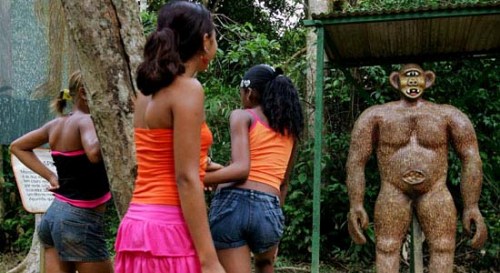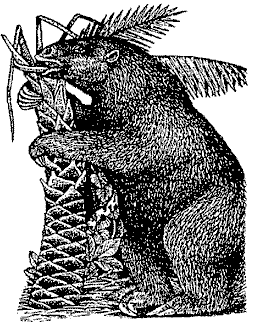
July 9, 2007
On July 9th, from NBC’s Today Show to worldwide news service rewrites of the Sunday New York Times article, this all is keeping this new Mapinguary mania alive. And we all thought the interest in this creature was dead a decade ago.
Sadly, the articles being spread from the UPI are often headlined with this one, “Numerous Tribes See Brazillian ‘Bigfoot’,” but then open with comments on the locals “have spoken throughout the years of seeing a giant, fearsome, slothlike creature that roams the rainforest.”
The articles are going with the Bigfoot/primate headlines, but talking only about the giant ground sloth theory. Why should we be surprised people are so confused?

Or…

The Mapinguary has been around in cryptozoological literature for quite some time. In the 1950s-1960s, Frank W. Lane (in Nature Parade), Bernard Heuvelmans (in On the Track of Unknown Animals), and Ivan T. Sanderson (in Abominable Snowmen: Legend Come to Life), all discussed Mapinguary.
Earlier published through the New York Times news service, as posted by Craig Woolheater on June 30th, and in a version printed today, July 8, 2007, in the Sunday New York Times, an article about the Mapinguary has quickly pushed the cryptid and the confusion back into the news. Larry Rohter’s “A Huge Amazon Monster Is Only a Myth. Or Is It?” brings into the consciousness of the general public the work of David Oren, his thoughts, and the Mapinguary, once again.
“It is quite clear to me that the legend of the mapinguary is based on human contact with the last of the ground sloths,” thousands of years ago, said David Oren, a former director of research at the Goeldi Institute in Belém, at the mouth of the Amazon River. “We know that extinct species can survive as legends for hundreds of years. But whether such an animal still exists or not is another question, one we can’t answer yet.” from the July 8, 2007, New York Times’ article, “A Huge Amazon Monster Is Only a Myth. Or Is It?”
Is the New York Times article any reflection of how all of this Mapinguary material plays, outside of cryptozoology? Maybe, maybe not. Certainly, online, via one of the easiest sources that pops up for people surfing to learn more about the Mapinguary, something is wrong.
Wikipedia, for example, says, “Science and even most cryptozoologists ignore the existence of any such creature.”
What? “Most cryptozoologists?” This is news to me.
Of course, whoever wrote that for Wikipedia is off-base.
Typically, the Mapinguary or Mapinguari, as described in local traditions, is ethnoknown throughout southern Brazil as a mostly red-haired, sloping, bipedal, long-armed giant ape – yes, a pongid – associated with unique “bottle” footprints. Cryptozoologists, including Bernard Heuvelmans, Ivan T. Sanderson, Mark A. Hall, and me, have considered the Mapinguary as a form of Bigfoot-like primate, as detailed in 1999’s Cryptozoology A to Z.
Bernard Heuvelmans, in On the Track of Unknown Animals, did theorize that the Mapinguary was a large primate. That book was published in French in 1955 and in English in 1958. Also, Heuvelmans reinforced his theory that Mapinguary is a primate in the journal Cryptozoology, Vol. 5, 1986, pages 21-22. Sanderson spent some time in Abominable Snowmen: Legend Come to Life going over the same theory. I shall never forgetten in 1961, my first reading of Sanderson’s book and finding his word imagery of the Mapinguary pulling the tongues out of cattle quite compelling. There seemed little doubt in my mind that it would take a very strong hominoid’s hand to do that.
But biologist David Oren redefined the issue in 1994 when he told the New York Times, and through Discovery magazine and a televised linked documentary, that Amazonians were in fact seeing supposedly extinct medium-sized ground sloths (apparently, the Mylodon, not the Megatherium).

The medium-sized ground sloth, Mylodon,
…versus…

…the giant ground sloth, Megatherium.
“In the 1980s and 1990s, David Oren conducted 50 interviews with Brazilian Indians, rubber planters, and miners who know about the animal. One group of Kanamarí Indians living in the Rio Juruá valley claimed to have raised two infant Mapinguaris on bananas and milk; after one or two years their stench became unbearable and they were released,” George Eberhart wrote in his Mysterious Creatures. “The ape-like variety is more often seen in Mato Grosso and Pará states, Brazil; and the sloth-like variety has been reported in Amazonas and Acre states, Brazil. Possible evidence also exists in Paraguay.”
Giant Sloths of many varieties lived, as part of the megafauna in South America, until 10,000 years ago. But cryptozoologists from Bernard Heuvelmans to David Oren find evidence for allegedly extinct Ground Sloth survival into modern times. There is reason to believe that the first South Americans hunted them, as “fresh” skin and dung were discovered in a cave in Argentina in 1895.
No less than the governor of Argentina, Ramon Lista, in the 1890s, said he saw a creature, which might match the description of a medium-sized, hairy ground sloth, while he was hunting in Patagonia.
Though some ostensible Mapinguary sightings may be of such an animal, a fossil ground sloth, others clearly may not be. Mark A. Hall wrote in the mid-1990s, “The popular discussions of David Oren’s research have done nothing to clear up the picture [regarding Mapinguary]. They may have only confused the issue all the more for the time being.”
Interestingly, the The New York Times was the foremost promotional media outlet for David Oren’s ideas in 1994, and now 13 years later, the same paper and Oren are back to tell us more about the Brazilian rainforest-dwelling Mapinguary, which Oren once speculated may have been evidence of the survival of a supposedly extinct medium-sized ground sloth.
I was happy to read of this new re-emergence of David Oren. In recent years, Wikipedia has tried to skeptically characterize Oren’s quest. For example, you could read this unreferenced passage there:
Among the many researchers who have tried to find evidence for the existence of the Mapinguari were the ornithologist David Oren. In his expedition he collected material that was later shown to be agouti fur, anteater feces, and moulds of tracks that were inconclusive. Oren himself came to believe that the Mapinguari does not exist and that any existing evidence is actually forged.[citation needed] “Mapinguari,” Wikipedia, copied July 8, 2008.
BTW, the Wikipedia entry has that “[citation needed]” within it; I didn’t added it there.
I wonder if David Oren would be surprised to discover that he is a skeptic of Mapinguary reports, according to Wikipedia?
About Loren Coleman
Loren Coleman is one of the world’s leading cryptozoologists, some say “the” leading living cryptozoologist. Certainly, he is acknowledged as the current living American researcher and writer who has most popularized cryptozoology in the late 20th and early 21st centuries.
Starting his fieldwork and investigations in 1960, after traveling and trekking extensively in pursuit of cryptozoological mysteries, Coleman began writing to share his experiences in 1969. An honorary member of Ivan T. Sanderson’s Society for the Investigation of the Unexplained in the 1970s, Coleman has been bestowed with similar honorary memberships of the North Idaho College Cryptozoology Club in 1983, and in subsequent years, that of the British Columbia Scientific Cryptozoology Club, CryptoSafari International, and other international organizations. He was also a Life Member and Benefactor of the International Society of Cryptozoology (now-defunct).
Loren Coleman’s daily blog, as a member of the Cryptomundo Team, served as an ongoing avenue of communication for the ever-growing body of cryptozoo news from 2005 through 2013. He returned as an infrequent contributor beginning Halloween week of 2015.
Coleman is the founder in 2003, and current director of the International Cryptozoology Museum in Portland, Maine.
Filed under Bigfoot, Books, Breaking News, Cryptomundo Exclusive, Cryptotourism, CryptoZoo News, Cryptozoologists, Cryptozoology, Eyewitness Accounts, Folklore, Fossil Finds, Media Appearances, Men in Cryptozoology, New Species, Out of Place, Photos, Pop Culture, Sasquatch